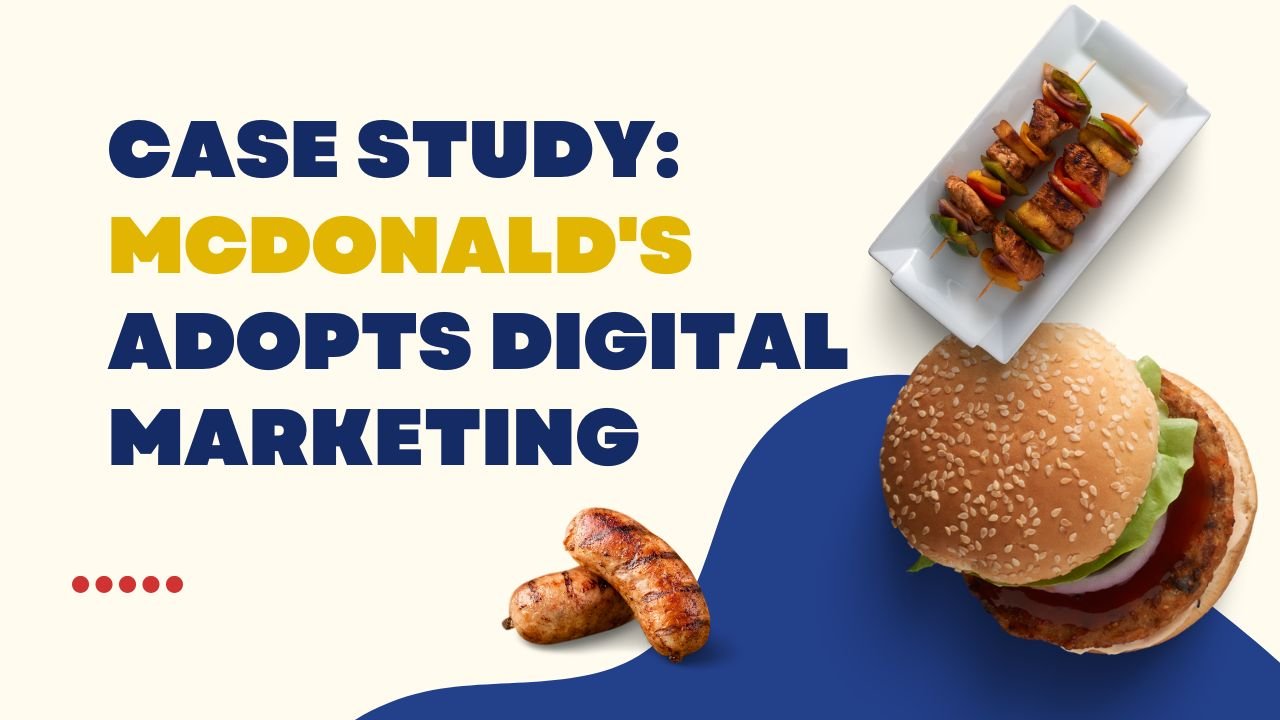
I’ll be honest with you, when I was a kid, McDonald’s wasn’t about apps or Instagram ads. It was about those golden arches on the highway that made you scream from the backseat, “Can we stop here?” That was their marketing: a giant M in the sky and a clown who somehow didn’t scare kids. And it worked for decades.
But times changed.
Now, if you want to grab people’s attention, you don’t just put up a billboard. You’ve got to live in their phones. You’ve got to slide into their feeds. And funny thing is… McDonald’s, the old-school fast-food king, actually pulled it off. They turned themselves into a digital powerhouse without losing that whole Big Mac nostalgia. This case study is kind of wild because it shows how even the giants have to hustle like scrappy startups sometimes.
Why McDonald’s Even Needed Digital Marketing
Think about it: McDonald’s is everywhere. Over 38,000 restaurants across more than 100 countries. You’d think they could just coast, right? Just keep serving fries and calling it a day.
But nope.
Competition got messy. Burger King started roasting them online. Wendy’s became the sass queen of Twitter. Health-conscious trends kicked in. And people… well, people started scrolling their phones instead of watching TV ads. If McDonald’s stayed stuck in the old-school playbook, they’d risk being that “your parents’ brand” kind of place.
So they had two options:
- Stick to what they’ve always done (TV, billboards, coupons stuffed in mailboxes).
- Or, dive headfirst into digital marketing and meet people where they actually are on apps, TikTok, Instagram, and Google search results.
You can guess what they chose.
The Pivot: From Billboards to Apps
I remember when McDonald’s launched their app. At first, it felt weird. Like, why would I need an app to order nuggets? But then you realize. Free fries on Fridays. Personalized deals. Easy ordering so you don’t have to fumble at the counter.
That’s when it hit me: this wasn’t just about convenience. It was about data. Every click, every order, every coupon you redeem it all tells McDonald’s something about you. What you like. When you eat. How much you’re willing to spend. And with that info, they can send you offers that feel like they’re reading your mind. Creepy? Maybe. Effective? Absolutely.
Truth be told, the app became their secret weapon. By 2022, their digital sales made up over 30% of their total sales in top markets. That’s billions of dollars, not just some side hustle.
Social Media: The Playground of Brands
Here’s where McDonald’s surprised me. They didn’t just show up on social media with boring product posts. They actually played the game.
- On Twitter (or X, if you insist on calling it that), they joke around with fans, reply to random memes, and jump on trending topics.
- On Instagram, they use bright visuals, nostalgia-driven posts, and limited-time hype like the McRib or celebrity meals.
- TikTok? Oh man. They nailed it. Partnering with influencers, creating challenges, even letting people remix their jingles.
I remember seeing that Travis Scott meal campaign in 2020. People went crazy. Stores literally ran out of ingredients. All because McDonald’s tapped into TikTok hype and meme culture. That wasn’t some old CEO idea that was pure digital fluency.
And here’s the cool part: they didn’t even over-explain. They just said, “It’s lit,” and let fans take over the storytelling. Sometimes the smartest marketing is stepping back and letting your audience do the heavy lifting.
Personalization: Making It Feel Like Yours
You might laugh, but one time I got a push notification from McDonald’s that said: “Hey, fries would go great with that burger.” And I was like how do you know I’m craving fries?
Turns out, personalization is their whole game now. The app remembers your orders. It suggests add-ons. It even nudges you at the exact time you usually eat lunch. McDonald’s isn’t just selling food anymore; they’re selling you your version of McDonald’s.
And this is where digital beats old-school ads. A billboard can’t whisper, “Hey, you forgot dessert last time.” But an app can. Creepy again, but undeniably smart.
Lessons From Mistakes (Because They Had Plenty)
Not everything went smooth, though. Digital isn’t just posting memes and watching sales spike. McDonald’s made their fair share of oops moments:
- Once, they tried an automated Twitter campaign that tweeted incomplete sentences. Trolls hijacked it.
- Another time, they used hashtags that backfired and led to negative stories being shared.
- And let’s be real the whole idea of pushing digital coupons means sometimes people get frustrated when deals vanish or apps glitch.
But here’s the thing: McDonald’s didn’t quit. They adapted. They learned when to apologize, when to laugh at themselves, and when to shut up and move on. That’s a lesson a lot of smaller brands forget.
Why It Worked (The Secret Sauce, If You Will)
Okay, let’s break it down why did McDonald’s digital shift actually work when so many brands flop?
- Consistency. They didn’t post for a month and disappear. They showed up daily, like a friend who never leaves the group chat.
- Relevance. They tapped into trends (without looking desperate). Travis Scott, BTS, Grimace Shake TikTok memes you name it.
- Value. The app deals weren’t fake discounts. They gave real worth. Free fries, buy-one-get-one, that stuff adds up.
- Global yet local. They kept the same branding worldwide but still adapted content to each country’s vibe.
And maybe the biggest reason: they were willing to reinvent themselves without losing their identity. The golden arches stayed. The fries stayed. The clown? Well, not so much. But you get the point.
A Quick Imaginary Scene
Picture this: it’s 1998. You’re sitting in a McDonald’s, eating a Happy Meal, watching kids trade toys. Marketing back then was about commercials on Nickelodeon and Ronald showing up at birthday parties.
Fast forward to now you’re scrolling TikTok, and suddenly there’s a Grimace Shake trend where people pretend to faint after drinking it. You laugh, maybe you even join in. Then later, you open the McDonald’s app and see a deal for that exact shake.
Different world, same brand. That’s the magic.
What Other Brands Can Steal From This Playbook
You don’t have to be McDonald’s with billions in the bank to learn from this. A few takeaways anyone can use:
- Meet people where they are. If your customers are on TikTok, don’t waste time on Facebook ads.
- Be playful. Nobody wants another boring sales pitch. Memes, jokes, even self-deprecating humor these go a long way.
- Reward loyalty. Coupons, exclusive drops, birthday deals. People love feeling special.
- Don’t fear mistakes. If you mess up online, own it. The internet is forgiving if you’re real.
Sometimes the lesson isn’t about doing everything perfectly. It’s about being human enough that people forgive the rough edges.
The Future of McDonald’s Marketing
So what’s next? AI-powered menus are already here. Some locations change digital boards based on time of day, weather, or what’s trending. Imagine walking in on a rainy day and the screen says: “Hot chocolate?” That’s not sci-fi that’s literally happening.
They’re also leaning into delivery partnerships, gamified loyalty programs, and who knows maybe one day a McDonald’s meal will come with an NFT (though I kinda hope not).
The point is: they won’t stop evolving. And if history’s any guide, they’ll keep finding ways to slide into our digital lives without us even realizing it.
A Personal Reflection to Wrap It Up
At the end of the day, watching McDonald’s dive into digital marketing feels like watching your uncle finally learn how to use WhatsApp but then suddenly he’s better at it than you. They didn’t just “catch up.” They set the pace.
And I think about that a lot. How a brand that already “won” decades ago didn’t sit back. They kept running, even when they didn’t need to. That says something about survival, about not letting pride get in the way of change.
Because, truth be told, digital marketing isn’t really about technology. It’s about people. It’s about knowing what makes someone laugh, what makes them hungry, what makes them click “order now.”
So yeah McDonald’s went from billboards to memes, from Ronald to Travis Scott, from paper coupons to push notifications. And they’re still here.
Kind of makes you wonder… if the world’s biggest fast-food chain can reinvent itself, what excuse do the rest of us have?
Table: McDonald’s Digital Marketing Wins vs. Challenges
| What Worked | Why It Mattered | Challenges Faced | What They Learned |
| Mobile app & loyalty program | Personalized deals boosted sales and data collection | App glitches, user complaints | Fix bugs fast, keep rewards consistent |
| Social media campaigns (Travis Scott meal, Grimace Shake) | Viral engagement drove real sales | Memes can spiral out of control | Embrace chaos but stay in control of the message |
| Influencer collaborations | Connected with Gen Z and younger audiences | Risk of backlash if influencers mess up | Choose partners carefully, monitor feedback |
| Personalized offers & push notifications | Increased repeat orders | Can feel “too creepy” if overdone | Balance personalization with privacy |
| Global consistency with local tweaks | Kept brand identity strong worldwide | Hard to please every culture | Adapt messaging without losing core identity |
FAQs: McDonald’s Digital Marketing
Q1: When did McDonald’s launch its mobile app?
McDonald’s began rolling out its app globally around 2015, but it really picked up steam in the late 2010s as they tied it to loyalty programs and personalized deals.
Q2: What was the Travis Scott meal campaign all about?
In 2020, McDonald’s partnered with rapper Travis Scott to promote his go-to order: a Quarter Pounder with cheese, bacon, lettuce, medium fries with BBQ sauce, and a Sprite. The campaign went viral on TikTok, leading to stores running out of ingredients.
Q3: How does McDonald’s use personalization?
The app remembers customer orders, suggests add-ons, and sends targeted deals based on eating habits, location, and time of day.
Q4: Did all of McDonald’s digital campaigns work?
Not really. Some hashtag campaigns backfired, and their automated Twitter attempt was hijacked. But overall, they bounced back quickly and kept experimenting.
Q5: What’s next for McDonald’s digital strategy?
Expect more AI-powered menus, gamified rewards, deeper app integration, and possibly even more influencer-led collaborations. They’ll keep blending convenience with digital engagement.





